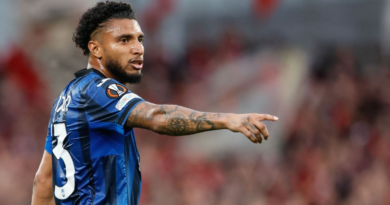Why did the Colts pivot? Will Taylor make Indy a playoff contender? Answering the 5 biggest questions
INDIANAPOLIS — When Indianapolis Colts running back Jonathan Taylor requested a trade at the start of training camp and said his surgically repaired right ankle would not yet allow him to return to the field, the idea of Taylor remaining with the Colts in the long term seemed uncertain, at best.
Now, more than two months later, Taylor has a new long-term deal that makes him one of the highest-paid players at his position, and the sides can move forward with the Colts sitting in the thick of the AFC South race with all four teams at 2-2. Taylor and the Colts reached agreement on a three-year, $42 million contract extension that includes $26.5 million guaranteed, sources told ESPN’s Adam Schefter on Saturday.
Taylor had requested a trade after the Colts told him during the offseason that an early contract extension was not in their plans. Taylor was in the final year of his four-year rookie contract.
Tensions built as Colts general manager Chris Ballard and owner Jim Irsay took a firm stance about not signing players to extensions during this offseason, given the team’s struggles last season (4-12-1) and the changes this year with new coach Shane Steichen and rookie quarterback Anthony Richardson.
But a resolution came Saturday, and Taylor, who led the league in rushing in 2021, is expected to play Sunday when the Colts host their division rival Tennessee Titans (1 p.m. ET, CBS).
Taylor has not played since December, when he was placed on injured reserve with a recurring ankle injury, but he was activated from the physically unable to perform (PUP) list earlier Saturday.
Here’s what to know about Taylor’s impact on the Colts and what it could mean moving forward.
Why did the Colts pivot?
After the Colts authorized Taylor and his agent, Malki Kawa, to seek out a trade partner in late August — which ultimately did not lead to a trade agreement — the Colts seemed adamant about their stance on the contract.
Asked during an August 30 news conference why he had decided not to extend Taylor (or other players), Ballard was unequivocal: “We won four games last year. We won four games.”
It was the final statement of the presser before Ballard departed the room, and it seemed to leave little room for a change in opinion.
But as the Colts have shown flashes in the first four games, and with the massive potential of Richardson, the Colts perhaps determined that their lack of explosive offensive players could be a hindrance to them in 2023.
Irsay on Saturday dared to think what his team’s offense might look like if Tayor returns to form.
“When you add Jonathan Taylor to what we already have on this roster, you ask yourself, how good can we be?” he said.
Additionally, as Taylor has continued to rehab his ankle in recent weeks, there have been multiple assessments from his coaches that he looks like the dangerous runner he once was. That might have influenced the Colts to act after previous concerns about how he’d bounce back from his injury.
Does this mean the relationship has been mended?
Irsay praised Taylor on Saturday, a notable development after Irsay had previously interjected himself into the Taylor saga with his public statements that were not received well by Taylor’s camp.
Irsay called an impromptu conference call with reporters and expressed elation over the team reaching the deal. It all suggests the relationship is on the way to being mended.
Irsay admitted that the contract was agreed to “sooner than I think should have happened,” but he countered those comments by saying, “I know these things can get difficult, but Jonathan’s a great young man.”
Both sides had actively been trying to turn the temperature down after things became heated at various points over the past couple months.
How will this help Anthony Richardson’s development?
The return of Taylor could be huge for Richardson. The Colts have struggled to force teams out of their 2-deep coverages, but a resurgent Taylor could force defenses to make tough decisions. Teams may have to add a defender to the tackle box, which could open up the deep passing game that has eluded the Colts so far.
The Colts rank 24th in yards per pass attempt (6.2) and want to generate a few more big plays to bump that number up.
Overall, the Colts are averaging 4.8 yards on all offensive plays – 23rd in the NFL.
Can Taylor make the Colts a playoff contender?
Time will tell, but the early indications suggest it’s not crazy to think the Colts could be in the mix. The AFC South standings are crowded at the moment, and if Richardson’s rapid development continues, there might need to be a shift in the Colts’ season projections.
We can look to Taylor’s past to see what happens when he gets hot. He averaged 130.2 rushing yards in the final five regular-season games of his rookie season (2020). The Colts went 4-1 in that stretch and made a successful push to reach the playoffs.
How big of a financial risk is this for Indy?
The exact salary-cap breakdown isn’t yet clear, but the Colts are scheduled to be among the teams with the most cap space in 2024. Whatever the particulars of Taylor’s deal, the Colts have substantial flexibility. They’ve spent a staggering amount of money on veteran quarterbacks in recent years, to little avail, but the arrival of Richardson — on a rookie contract that averages $8.5 million — allows the Colts to gain flexibility.
Among the coming financial decisions facing the Colts will be the decision to extend wide receiver Michael Pittman Jr.’s contract after the season. He is scheduled to be a free agent in the spring and has averaged 75.7 catches in his first three seasons.
Big-salary Colts players like guard Quenton Nelson, tackle Braden Smith and defensive tackle DeForest Buckner are all under contract through at least next season.




